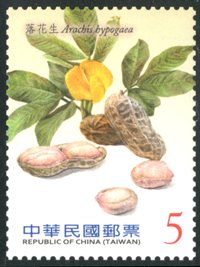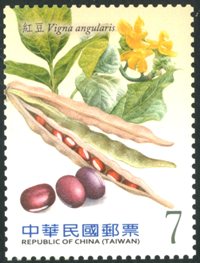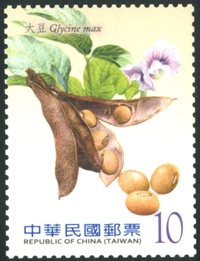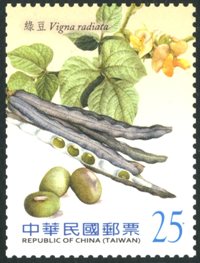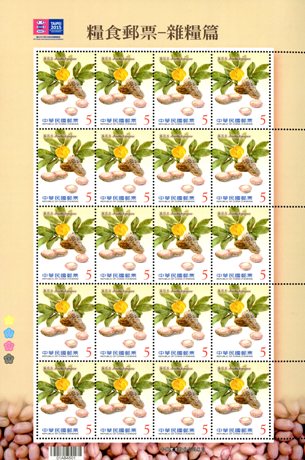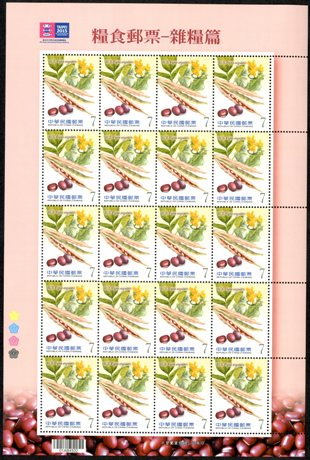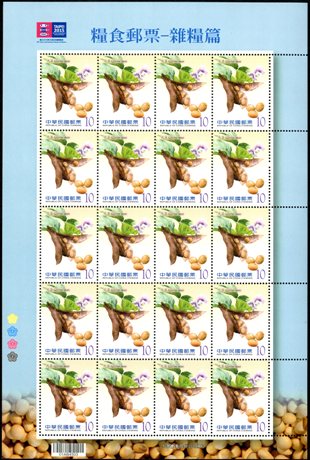Sp.618Food Crop Postage Stamps - Coarse Grains
| Stamp SN | D618 |
|---|---|
| Stamp Name | Sp.618Food Crop Postage Stamps - Coarse Grains |
| Stamp Cat Standard | Special Stamps |
| Stamp Cat | Agriculture |
| Issue date | 2015-01-28 |
| Suspersion date | |
| Dimension of stamps(mm.) | 30 × 40 (mm) |
| Size of souvenir Sheet (mm.) | |
| Printer | Cardon Enterprise Co., Ltd. |
| Drawer | |
| Designer | Hung-tu Ko |
| Photographer | |
| Engraver | |
| Creative Director | |
| Sheet composition | 20 (4 × 5) |
| Print color | Colorful |
| Process | Offset |
| Paper | Phosphorescent stamp paper |
| Back | |
| Perforation | 131/2 × 121/2 |
Following up with the release of "Food Crop Postage Stamps - Grains" in 2013, Chunghwa Post now issues a set of four stamps, featuring four coarse grain species in the Fabaceae family. The designs follow:1. Arachis hypogaea (NT$5): Commonly known as peanuts, Arachis hypogaea is an annual, herbaceous plant. The stalks are either erective, creeping, clustered, or semi-erective. The leaves are opposite, pinnate, and patterned in alternate phyllotaxy. The flowers are papilionaceous. The pods are longish, like a stocking. The skin of the seed is pale red. Primarily grown in Yunlin, Changhua and Chiayi, this food crop is popularly cooked as fresh food, or used to make cooking oil and processed foods. 2. Vigna angularis (NT$7): Commonly known as red beans, it is an annual, herbaceous plant. The stalk is erective, and covered in trichomes. The cotyledons are opposite; the true leaves, patterned in alternate phyllotaxy, consist of three small leaves in circular, oblong, sword or spear shapes. Its flowers are papilionaceous with corollas, the vexillum of the petals has short teeth. The pods are cylindrical, with a beak-like tip. The seeds are ovate and dark red in color. It is chiefly grown in Pingtung and Tainan as a popular ingredient for sweets. It is also an excellent medicinal food. 3. Glycine max (NT$10): Commonly known as soybean, it is an annual, herbaceous plant. The stalk is either erective, semi-erective, or trailing. The compound leaves are trifoliolate and lanceolate (needle-like). Its flowers are papilionaceous in raceme. The pods are green when they first sprout; they begin to yellow, and darken into a brownish color when mature. The seeds are ovate; a small variety of the seeds are oblong or oblate. The skin of the seed is either yellow, green, or black. Extensively grown in Yunlin, Chiayi and Tainan, the crop is used for food and cooking oil production; it is also a vital industrial-purpose material. 4. Vigna radiata (NT$25): Commonly known as mung bean, it is an annual, erective herbaceous plant. The stalk is light green, covered sparsely in trichomes. The compound leaves are trifoliolate; the small leaves are ovate, and their edges are at times jagged. The plant is covered in trichomes, with papilionaceous flowers. The pods are shaped in a narrow, elongated circle. The seeds are mostly green, but yellow and golden-yellow varieties can also be found. The plant is largely grown in Tainan and Chiayi. Its sprouts make a popular vegetable dish. It can also be processed for making glass noodles and pastries.
(1) First Day Cover: NT$ 2 apiece(2) Folder (with and without mount): NT$ 5 apiece(3) Loose-leaf album page: NT$ 8 apiece (4)Pre-cancelled FDC affixed with one NT$5-denominated stamp: NT$ 7 apiece(5) Pre-cancelled FDC affixed with a complete set of stamps: NT$ 49 apieceTo purchase the relative philatelic products, please go directly to the post office branches, or order on line at http://stamp.post.gov.tw
YOU MAY ALSO LIKE
By category
By Topic
By Year






